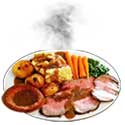Accompaniments for roast meals for that good old-fashioned taste

For a wonderful roast meal with the taste of years ago, there are certain things that are essential. Proper dripping, gravy and roast root vegetables have their own pages. This page describes some extras, like sausages, stuffing and sauces and how to prepare and cook them - all from remembered from older women did, but adapted for modern convenience.
____
By the webmaster, based on watching older people cook, informal discussions and years of practice
Stuffing for roast chicken
In the past women made their own stuffing from breadcrumbs which they made from stale or oven-dried bread and they flavoured the breadcrumbs with chopped herbs. Then they bound the mixture together with hot water to make a solid lump which they stuffed into the cavity of the chicken. Hence the name stuffing. My memory is that the herbs were always sage and onion, but I can't say that other herbs weren't used in some households.
Two things have changed nowadays. One is that excellent stuffings are readily available in the shops in dried form and the other is the need to ensure that the stuffing doesn't absorb salmonella from inside a chicken and remain party uncooked. This has led to the stuffing being cooked separately and no longer being stuffed into the chicken.
My stuffing is always sage and onion which I prepare by mixing with hot water as described on the packet. Then I place it in an enamel dish beside the roasting pan - but more of this below.
Incidentally I find that it is really important to have a stock of the old-style enamel or metal dishes because they heat through much more quickly than glass or ceramic.
Sausages and sausage meat
When I cook my roasts it is always with an eye to being able to make bubble and squeak the next day. So I always include sausages.
Sausages are a more attractive accompaniment if they are short like the ones sold for sausages on sticks. However, bought ones are seldom sold in a range of varieties. So I prefer to buy my favourite regular length chipolata sausages, pinch and twist them half way along and then cut them myself into shorter lengths. Each twist converts one normal length sausage into two short ones.
I cook most of my sausages placed on top of the stuffing. This keeps the stuffing moist as it cooks and doesn't lose the flavoursome fat that seeps out of the sausages as they cook. I use tongs to turn each sausage once during cooking.

Sausages on stuffing ready for cooking.

Sausages and stuffing after cooking.
Other accompaniments to roast meals
Roast beef was traditionally served with Yorkshire pudding and horseradish sauce; lamb with suet dumplings and mint sauce, mint jelly or redcurrant jelly and pork with apple sauce. I won't add any advice about the sauces because most of today's shop-bought ones are excellent. However, you may like to know that it was my father's job in the 1940s to make the mint sauce for the family. He used a knife and a chopping board to chop mint from the garden a then added vinegar. I don't know if he also added sugar, but anyway I thought it was horrible and I much prefer today's bought mint jelly. I do, though, usually make my own apple sauce but that's because I have the apples from the garden and the easy way of cooking them in the microwave. I suspect that the result is better than ready-made shop-bought apple sauce, because my apple crumble with my own apples is far superior to that made with the tinned apple pie filling that I use occasionally when my apples have run out.
| sources | webmaster | contact |
Text and images are copyright
If you can add anything to this page or provide a photo, please contact me.



